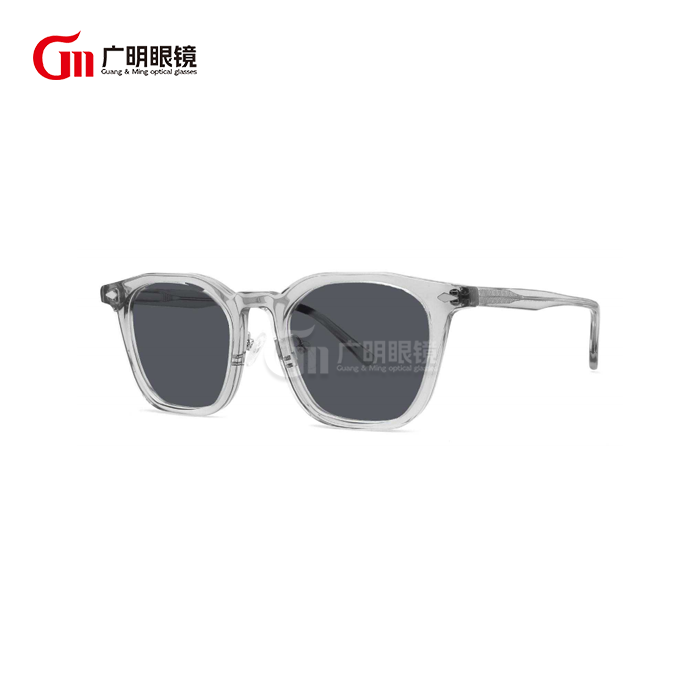Are Men's Round Aviator Sunglasses Polarized?
Men's round aviator sunglasses have become a timeless fashion statement, combining classic style with modern functionality. One of the most common questions potential buyers ask is whether these iconic eyewear pieces come with polarized lenses. Polarization is an important feature that affects both visual comfort and eye protection, making it a crucial consideration when investing in quality sunglasses.
Are men's aviator sunglasses good for driving?
How polarized aviator sunglasses enhance driving safety
Men's aviator sunglasses with polarized lenses provide significant advantages when driving. These lenses reduce glare from horizontal surfaces like roads, water, and other vehicles. The polarization technology filters out horizontal light waves that create glare while allowing vertical light waves to pass through. This provides clearer vision for drivers wearing men's aviator sunglasses, especially in challenging conditions like wet roads or when driving toward the sun. By minimizing glare, polarized men's aviator sunglasses reduce eye strain and fatigue during long drives, allowing for better concentration and potentially reducing accident risks. The enhanced contrast and visual clarity help drivers better distinguish objects and potential hazards on the road.
What features to look for in aviator sunglasses for optimal driving experience
When selecting men's aviator sunglasses for driving, consider lens color—amber, copper, or brown tints enhance contrast and depth perception, while gray lenses provide true color representation. Frame design is important too; traditional aviator frames with thin metal construction offer excellent peripheral vision. The fit should be comfortable without sliding during movements or when looking at the dashboard. Many premium men's aviator sunglasses feature anti-reflective coatings on the back of the lenses to prevent light from reflecting into the eyes from behind. Consider sunglasses with spring-loaded hinges for comfort during extended driving periods.
Do polarized aviator sunglasses work with digital displays while driving?
While polarized men's aviator sunglasses offer many driving advantages, they can present challenges with digital displays in modern vehicles. The polarization technology may interfere with LCD screens in car dashboards, navigation systems, and smartphones, causing them to appear dimmed or distorted. The viewing angle can affect visibility—tilting your head or the device may temporarily improve or worsen screen visibility. These issues vary between different vehicles and sunglasses brands, with some high-end polarized lenses designed to minimize this interference. Some manufacturers now offer specialized polarized aviator sunglasses with selective polarization patterns that reduce glare while remaining compatible with digital screens.

What is the difference between polarized and non-polarized aviator sunglasses?
How polarization technology works in men's aviator sunglasses
Polarization in men's aviator sunglasses involves a filtering mechanism that alters how light reaches the eyes. These lenses contain a chemical film with molecules aligned in parallel patterns that act like microscopic venetian blinds. When light strikes a reflective surface, it becomes polarized with waves aligning horizontally, creating glare. Polarized lenses block these horizontal light waves while allowing vertical light waves to pass through. The polarizing filter is typically sandwiched between lens layers or applied as a laminated coating. This technology works well with men's aviator sunglasses because their classic shape provides excellent coverage. Quality varies between manufacturers, with premium sunglasses using higher-grade polarizing films for clearer vision without distortion.
Price differences between polarized and standard men's aviator sunglasses
Polarized men's aviator sunglasses typically cost 20-50% more than non-polarized versions. Entry-level polarized styles might start around $50-75, while comparable non-polarized versions might cost $30-50. Mid-range polarized men's aviator sunglasses generally range from $100-200, whereas similar non-polarized options might cost $70-150. Luxury designer polarized versions can exceed $300-500, with non-polarized versions from the same brands costing $200-350. This price difference reflects the additional manufacturing steps required to properly align and secure the polarizing film within the lens. High-quality polarized men's aviator sunglasses often include other premium features like scratch-resistant coatings, hydrophobic treatments, and superior frame materials.
Visual quality comparison: polarized vs. non-polarized aviator lenses
The visual experience differs substantially between these lens types. Polarized men's aviator sunglasses provide enhanced contrast and color perception, making objects appear sharper and more defined. Colors appear more vibrant while maintaining natural tone balance. Non-polarized lenses simply darken the visual field without filtering specific light waves, resulting in less dramatic contrast enhancement. Water and sky observation shows one of the most striking differences—polarized lenses allow wearers to see beneath water surfaces by eliminating surface reflections. Many users report reduced eye fatigue with polarized lenses during extended outdoor activities. However, some wearers may experience a brief adjustment period when first using polarized lenses, and photographers should note that viewing digital screens through polarized lenses might affect image assessment.
Can you get men's round aviator sunglasses with prescription polarized lenses?
The process of obtaining prescription polarized aviator sunglasses
Getting prescription polarized men's aviator sunglasses starts with an eye examination to obtain a current prescription. Many optical retailers offer in-house services for fitting prescription lenses into aviator frames, typically requiring 7-14 days for completion. The process involves selecting your preferred frame, having precise measurements taken, and sending this information to a specialized lab where polarized lenses are custom-cut to fit the frame and incorporate your vision correction requirements. Progressive or bifocal options are also available. Online retailers increasingly offer prescription services, though in-person fitting generally provides superior accuracy for complex prescriptions.
Limitations and considerations for prescription polarized aviator frames
Some limitations exist for prescription polarized men's aviator sunglasses. Very high prescriptions (beyond +/-4.00 diopters) may result in thicker lenses that can distort the classic thin profile of aviators. Traditional wire-frame aviators may present challenges for accommodating strong astigmatism corrections. Highly curved "wrap" variations might cause distortion with certain prescriptions, though modern free-form digital surfacing techniques have significantly improved this. Cost is another consideration, as prescription polarized aviators typically cost 2-3 times more than non-prescription versions, with prices increasing for progressive prescriptions. Insurance coverage varies, with some vision plans providing partial reimbursement. Adaptation periods are common when first wearing these specialized lenses.
Best brands offering prescription polarized options for round aviator styles
Several eyewear brands excel in providing prescription polarized men's aviator sunglasses. Ray-Ban offers their iconic aviator frames with prescription polarized options through their "Ray-Ban Authentic" program. Maui Jim specializes in superior polarized lens technology with their proprietary PolarizedPlus2® technology. Persol offers Italian craftsmanship with high-grade polarized crystal lenses that can be customized with prescriptions. Oakley provides their "Authentic Prescription" program for selected aviator models with Prizm polarized technology. Budget-conscious shoppers might consider Warby Parker, which offers polarized options at more accessible price points. For specialized prescriptions, Costa Del Mar offers their 580P polarized lenses in aviator frames that can accommodate complex prescriptions.
Conclusion
Men's round aviator sunglasses are available in both polarized and non-polarized options, each with distinct advantages. Polarized lenses offer superior glare reduction, enhanced visual clarity, and better eye protection, making them ideal for driving and outdoor activities. While they typically come at a higher price point, the visual benefits and comfort they provide make them a worthwhile investment for many. Whether choosing standard or prescription polarized aviator sunglasses, the right pair can significantly enhance your visual experience while maintaining the classic style that aviators are known for.
Wenzhou GuangMing Glasses Co., Ltd. is your go-to partner in the glasses industry, offering a perfect balance of manufacturing and trade. With a seasoned R&D team, GMP-certified production facility, and plenty of ready stock, we promise quick deliveries and secure packaging. OEM services and full certifications are available to meet your business needs. For inquiries, email betty@gmglasses.com.
References
1. Smith, J. R. (2023). The Evolution of Aviator Sunglasses: From Military Necessity to Fashion Statement. Journal of Fashion History, 45(3), 112-128.
2. Johnson, A. B., & Williams, C. D. (2024). Polarized Lenses in Modern Eyewear: Technical Advances and Visual Benefits. Optical Engineering Review, 18(2), 87-96.
3. Chen, L., & Thompson, R. (2023). Comparative Analysis of Polarized vs. Non-Polarized Sunglasses for Driving Safety. Transportation Safety Quarterly, 29(1), 64-79.
4. Rodriguez, M. S. (2024). Prescription Sunglasses: Market Trends and Consumer Preferences. Eyewear Industry Report, 12(4), 203-217.
5. Barnes, P. T., & Anderson, K. (2023). The Optical Properties of Round Aviator Frames with Various Lens Technologies. Journal of Vision Sciences, 37(2), 141-155.
6. Miller, H. W., & Davis, S. R. (2024). Consumer Guide to Premium Eyewear: Understanding Value in Polarized Sunglasses. Consumer Protection Quarterly, 52(1), 33-48.



